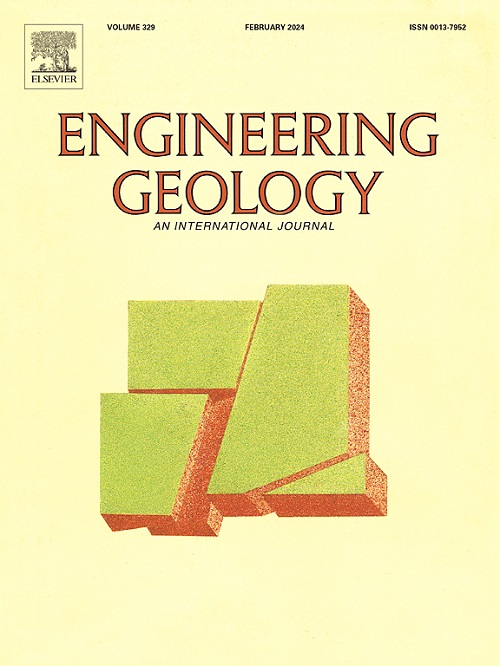Stability analysis of earth slopes with counterweight fill: Kinematic limit analysis
IF 6.9
1区 工程技术
Q1 ENGINEERING, GEOLOGICAL
引用次数: 0
Abstract
Counterweight fill, which involves adding mass to potentially unstable areas, such as the slope base or toe, is a common and effective technique for slope stabilization owing to its ease of installation and familiarity. As both a temporary and permanent preventive measure, both the design and analysis of counterweight fill require careful consideration to ensure a balanced distribution of the added weight. However, in practice, brief and empirical guidelines have been widely adopted, often without standardization. This study aimed to quantify the beneficial effects of counterweight fill on slope safety by analyzing the respective failure mechanisms. To achieve an optimal design, strategic fill configurations, including fill geometry, height, and area, are discussed. Further considerations include the strength and weight of counterweight fills, demonstrating the importance of fill positioning and material selection for slope stabilization. The addition of fill mass at the toe of the slopes could significantly strengthen the slope stability, potentially doubling the stability factors, assuming the fill used the same material as the slope. A strong dependence of the failure mechanisms of the fill-reinforced slopes was observed, leading to the potential local collapse of the restricted slope failure. The effectiveness of counterweight fills is affected by fill configuration and material properties, highlighting the importance of quantitative analysis and design.
配重填方土坡稳定性分析:运动学极限分析
配重填筑是一种常见而有效的边坡稳定技术,因为它易于安装和熟悉,它涉及到在潜在的不稳定区域(如边坡底部或脚趾)增加质量。作为一种临时和永久的预防措施,配重填充物的设计和分析都需要仔细考虑,以确保增加的重量的平衡分布。然而,在实践中,广泛采用了简短的经验性准则,往往没有标准化。本研究旨在通过分析配重填筑对边坡安全的有益影响,量化配重填筑对边坡安全的有益影响。为了实现最佳设计,战略填充配置,包括填充几何形状,高度和面积,进行了讨论。进一步的考虑包括配重填充物的强度和重量,证明了填充物定位和材料选择对边坡稳定的重要性。假设填土采用与边坡相同的材料,在坡脚处增加填土质量可以显著加强边坡稳定性,可能使稳定系数增加一倍。观察到填土加固边坡的破坏机制有很强的依赖性,导致局限性边坡破坏的潜在局部崩塌。配重填充物的有效性受填充物结构和材料性能的影响,突出了定量分析和设计的重要性。
本文章由计算机程序翻译,如有差异,请以英文原文为准。
求助全文
约1分钟内获得全文
求助全文
来源期刊

Engineering Geology
地学-地球科学综合
CiteScore
13.70
自引率
12.20%
发文量
327
审稿时长
5.6 months
期刊介绍:
Engineering Geology, an international interdisciplinary journal, serves as a bridge between earth sciences and engineering, focusing on geological and geotechnical engineering. It welcomes studies with relevance to engineering, environmental concerns, and safety, catering to engineering geologists with backgrounds in geology or civil/mining engineering. Topics include applied geomorphology, structural geology, geophysics, geochemistry, environmental geology, hydrogeology, land use planning, natural hazards, remote sensing, soil and rock mechanics, and applied geotechnical engineering. The journal provides a platform for research at the intersection of geology and engineering disciplines.
 求助内容:
求助内容: 应助结果提醒方式:
应助结果提醒方式:


